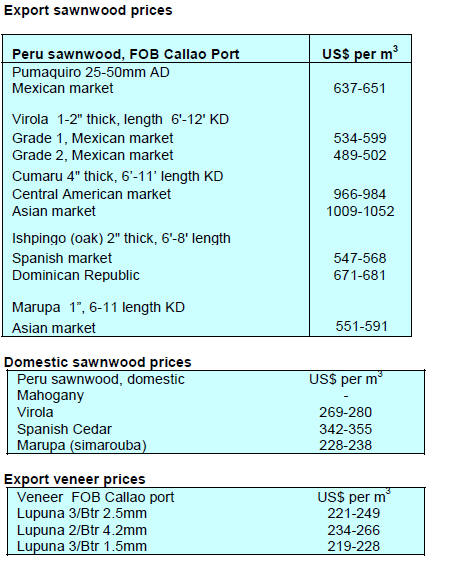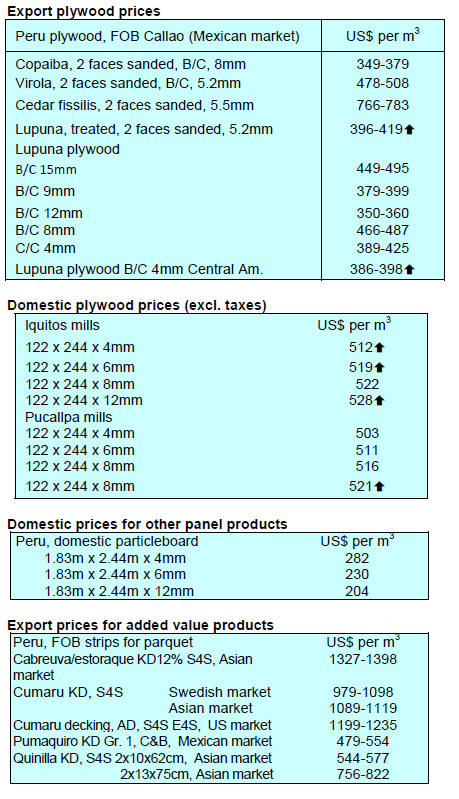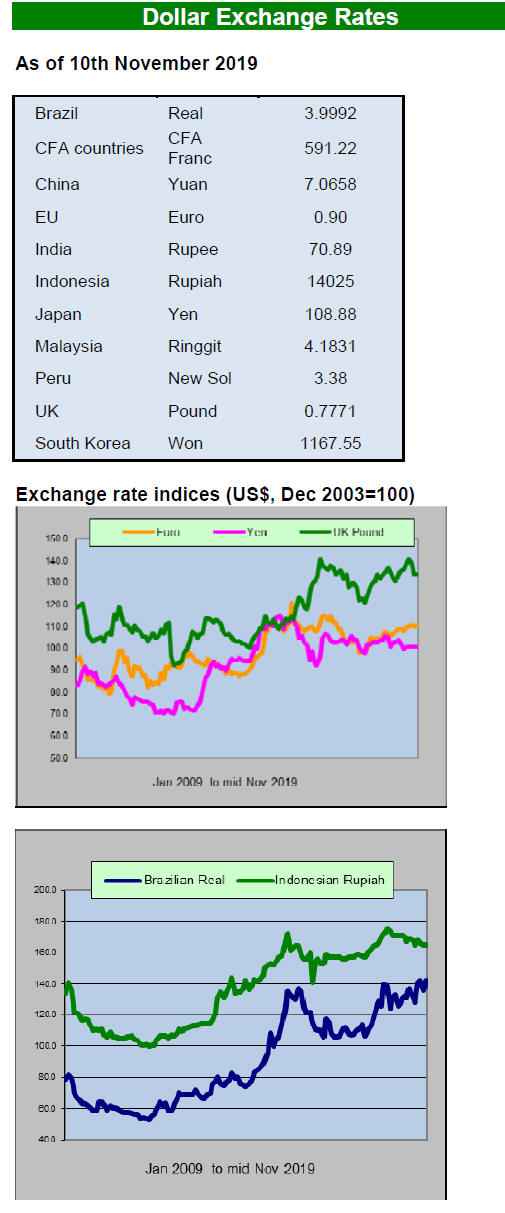3.
MALAYSIA
New regional trade deal gets closer
The Malaysian business community is excited over recent
positive developments in regional trade. Although India
pulled out at the last minute, 15 other countries—the ten
member countries of the Association of Southeast Asian
Nations (ASEAN) plus China, Japan, the Republic of
Korea, Australia and New Zealand—agreed in Bangkok
on plans for what could become the world's biggest trade
agreement, the Regional Comprehensive Economic
Partnership (RCEP). Countries aim to sign the agreement
next year to start freeing up trade between members.
Few details have been released, but the agreement will
progressively lower tariffs across many areas. Its backers
say that, just as importantly, the agreement will let
companies export the same product anywhere within the
bloc without having to meet separate requirements and
complete separate paperwork for each country.
The 15 participating countries make up nearly one-third of
the world’s people (it would have been nearly half with
India) and nearly one-third of global domestic product.
India can join later, if it wishes.
Departmental restructuring underway in Sarawak
The Sarawak Forest Department is undergoing a
restructuring. According to Director Hamden Mohammad,
the restructuring will more clearly define the roles and
responsibilities of the Forest Department and the Sarawak
Forestry Corporation (SFC) in managing forest resources
and conserving Sarawak’s biodiversity.
“As agreed, the Forest Department will regulate all forest
areas in Sarawak in the aspect of management and
operations, while SFC will manage the national parks and
wildlife protection,” said Director Hamden.
In other news, talks are underway with Singapore for
Sarawak to produce semi-finished furniture for companies
based in Singapore..
“We are thinking of a dedicated furniture park for
Singapore companies in Sarawak, so that you can get the
raw materials that you need to produce good furniture. We
can perhaps increase export of our furniture,” said
Sarawak Chief Minister Abang Johari Tun Openg.
Exports in first eight months of 2019
The Statistics Department has released export data for the
first eight months of 2019. Sarawak’s log exports totalled
937,006 cu.m in January–August (down from 986,997
cu.m in the same period in 2018) at a value of MYR
501,982,000 (down from MYR 537,005,423).
The Republic of Korea has purchased no logs from
Sarawak to date this year. Indonesia is now the largest
importer of Sarawakian logs.
The total value of Sabah’s timber product exports was
MYR 749,900,129, down by 25% compared with the same
period in 2018 (MYR 1,008,048,127).
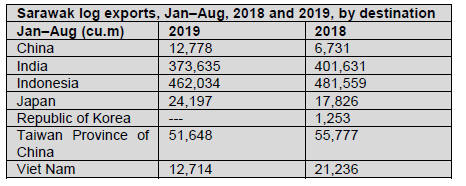
It will be seen from the above that Indonesia is
the major
market for sarawak’s log exports.

4.
INDONESIA
Log production predicted to grow by 15%
next year
The Association of Indonesian Forest Concessionaires
(APHI) estimates that log production will grow by 10–
15% next year, both from industrial plantations (HTI) and
natural forests, according to a report in Bisnis. APHI
Executive Director Purwadi Soeprihanto said that the
production of logs from natural forests this year is
predicted at 5.4 million m3 and HTI production is
estimated to be stable at 40 million m3.
See: https://ekonomi.bisnis.com/read/20191105/99/1166881/
produksi-kayu-bulat-diprediksi-tumbuh-hingga-15-persen
Chinese investors relocate furniture factories to Java
According to a report in TEMPO, Indonesia’s Investment
Coordinating Board (BKPM) has indicated that 59
Chinese investors in wood and furniture businesses will
relocate factories to Central Java.
The reasons given for the relocation include Indonesia's
stable investment climate and the simple licensing process
in Central Java.
See:
https://en.tempo.co/read/1268924/59-chinese-investorsrelocating-
furniture-factories-to-java
Plywood, bamboo, rattan listed in US GSP
programme
The US Trade Representative (USTR) has indicated that
laminated bamboo plywood (HS 44121005), thin plywood
measuring less than 66 mm (HS 44123141155), and rattan
for hand-made souvenirs (HS 46021223) are eligible for
cuts in Generalized System of Preferences tariffs on
exports to the US.
US says trade preference talks to conclude soon
US Commerce Secretary Wilbur Ross said recently that a
US review of a trade preference facility for Indonesia
would conclude soon, and he predicted “far more
investment” by US companies in Indonesia as a result,
according to a report in TEMPO.
The USTR has been reviewing Indonesia’s eligibility for
the GSP facility for more than a year due to concerns
about market access for US goods, services and
investment.
By retaining GSP and opening up more market access in
both directions, Indonesia and the US aim to more than
double their trade in the next five years to US$ 60 billion
(up from US$ 28.6 billion in 2019), according to
Indonesian Chief Economic Affairs Minister Airlangga
Hartarto. “We want to open access for our furniture and
textiles and we have programmes to import more cotton
and wheat from the US,” he was reported as saying.
See:
https://en.tempo.co/read/1269174/u-s-says-talks-on-indonesiatrade-
preference-to-conclude-soon
Association urges streamlined regulations
The Indonesian Furniture and Crafts Industry Association
(HIMKI) has urged the government to immediately fix
regulations that hamper the export of Indonesian furniture
and handicraft products.
HIMKI Secretary General Abdul Sobur identified the
Timber Legality Verification System (SVLK) as a
particular obstacle, saying that it should not be required
once the timber reached downstream industries such as
furniture manufacture, if the upstream supply has already
been verified as legal. Mr Sobur said that reducing
regulations on exports was key to reducing Indonesia’s
trade balance deficit.
See: www.industry.co.id/read/57089/ekspor-furnitur-dankerajinan-
loyo-himki-desak-pemerintah-benahi-regulasi
Furniture exports down
The export performance of Indonesian furniture and
handicraft industry products has stagnated in recent years,
according to a report in Bisnis. The export value of
industrial products made from wood and rattan was
US$ 1.49 billion in 2018, down from US$ 1.63 billion in
2017. The Director of the Forest and Plantation Products
Industry of the Ministry of Industry (Kemenperin), Edy
Sutopo, blamed this partly on logistics and a lack of
attractive designs.
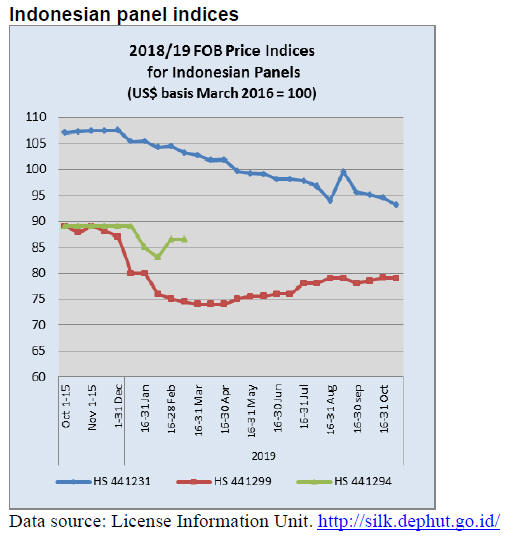
5.
MYANMAR
Myanmar grapples with FLEGT
The Workshop to Formulate the Road Map on FLEGT
was conducted in Nay Pyi Taw in early November
involving the national and subnational members of the
Multistakeholder Group and representatives of the EU and
the European Forest Institute (EFI), according to the
Forest Department.
Moreover, an EU representative was in Myanmar in early
November amid uncertainty about the status of
negotiations on the voluntary partnership agreement
(VPA) between the EU and Myanmar. Myanmar’s Forest
Law Enforcement, Governance and Trade (FLEGT)
process with the EU began in 2015.
One exporter said that timber businesses were under
pressure from two fronts: increasing difficulty in accessing
the EU market, and declining harvest volumes. The
exporter said the private sector was in a weak position to
tackle market access issues.
According to a source close to EU importers, the European
Timber Trade Federation recently sent an expert from
NepCon (a non-profit organization working
to support better land management and business practices)
to review legality issues in Myanmar.
The expert reportedly met with officials from several
institutions, including the Forest Department, the
Myanmar Timber Enterprise and the Myanmar Forest
Certification Committee.
Business gets a little easier
Myanmar has moved up in the World Bank’s Ease of
Doing Business ranking, from 171 in 2018, according to U
Thant Sin Lwin, Director-General of the Directorate of
Investment and Company Administration (DICA), as
reported by state media.
The World Bank report found that Myanmar showed
substantial improvements in five areas of doing business—
1) starting a business; 2) dealing with construction
permits; 3) registering property; 4) protecting minority
investors; and 5) enforcing contracts.
Myanmar launched an online company registry platform,
merging several procedures and reducing the need for inperson
interactions. It also enacted the Myanmar
Companies Law, which stipulates the duties of directors
and changes in shareholdings.
Myanmar expects to attract more investment as
manufacturers seeking to relocate production from China
to skirt US tariffs encounter capacity constraints in
Vietnam, according to a report in Bloomberg.
With labour wages rising in Thailand, some Thai
enterprises are discussing moving their businesses to
Myanmar, according to U Thant Sin Lwin. These
businesses are engaged in manufacturing LEDs, auto parts
and accessories, among other things. Globally, the
ongoing China–US trade dispute saw combined FDI to the
CLMV countries (Cambodia, Lao PDR, Myanmar and
Vietnam) rise by 4% in 2018, to US$ 23 billion.
More foreign banks to operate in Myanmar
The Central Bank of Myanmar (CBM) will issue two types
of licences—foreign bank branch licences and subsidiary
licences—in the upcoming third round of licensing from 1
January 2020, according to a statement, as part of an
initiative to open up the domestic banking market to
foreign banks.
Nine foreign banks got the green light in 2014 and four in
2016, in which they are allowed to conduct onshore
wholesale banking business. Branch licensees are allowed
to establish one place of business only, and a minimum
paid-in capital of US$ 75 million is required for
operation.
See: https://elevenmyanmar.com/news/cbm-to-issue-two-typesof-
licenses-for-foreign-banks
6. INDIA
Low demand, high taxes plague Kutch
timber industry
Asia’s biggest notified Imported Timber Conversion Zone,
in the district of Kutch (in Gujarat in western India), is
struggling, according to a report in The Times of India.
A reduction in demand has forced several sawmills to cut
production, and the high Goods and Services Tax (GST)
and a depreciation of the rupee have eroded their margins.
GST is applicable to any goods or services imported into
or exported from India.
The rate of the GST on timber imports is currently
18%.
The Kandla Timber Association has requested a reduction
in the rate of the IGST to 5%.
The upfront payment of GST and other expenses is a high
imposition on the industry, which may take up to 8 months
to manufacture and sell the finished products using the
imported timber (and thereby recoup GST outlays).
Nearly 70% of India’s timber imports go through ports in
Kandla and Mundra. India’s largest timber cluster lies
within 15 km of Deendayal Port, previously known as
Kandla Port, stretching between Gandhidham and Anjar.
The Deendayal Port Trust’s plan to develop a furniture
park in the region has hit a roadblock, with industry
players reluctant to take up plots on lease due to high rent.
See:
http://timesofindia.indiatimes.com/articleshow/71872354.cms?ut
m_source=contentofinterest&utm_medium=text&utm_campaign
=cppst
Amazon expands furniture range
Amazon India has expanded its range in the furniture
category to over 160,000 products, especially from small
and medium-sized businesses, ahead of the festive season,
according to a report by Press Trust India.
Amazon, which has pumped billions of dollars into its
Indian operations in the last few years, said its furniture
business has grown by over 120% in the last year. Around
25% of furniture buyers use finance schemes, such as nocost
equated monthly instalments (EMI).
More than 65% of Amazon’s sales are from customers
beyond the big urban conglomerates in cities such as
Nasik, Raipur, Vellore, Udupi, Kota, Kollam and
Palakkad. Online marketing is also enabling small and
medium-sized businesses in artisan hubs to sell their
products to a nationwide customer base.
The press release from the Ministry of Commerce and Industry
can be found at:
https://eaindustry.nic.in/pdf_files/cmonthly.pdf
Real estate industry under pressure
A slump in the residential property market means that
many builders are struggling to repay loans to shadow
lenders (housing finance firms outside the regular banking
sector, also known as non-banking financial companies—
NBFCs).
Indian financial authorities, including the central bank and
government, have said that the banking sector’s bad loans
are on the decline for the first time in four but the number
of property developers falling into bankruptcy has doubled
in the past nine months, piling pressure on shadow lenders.
See: //economictimes.indiatimes.com/
articleshow/71563262.cms?utm_source=contentofinterest&utm_
medium=text&utm_campaign=cppst
Imported plantation teak
C&F prices for imported teak at Indian ports from various
sources continue within the same range as given in
previous issues (and as shown in the table below).
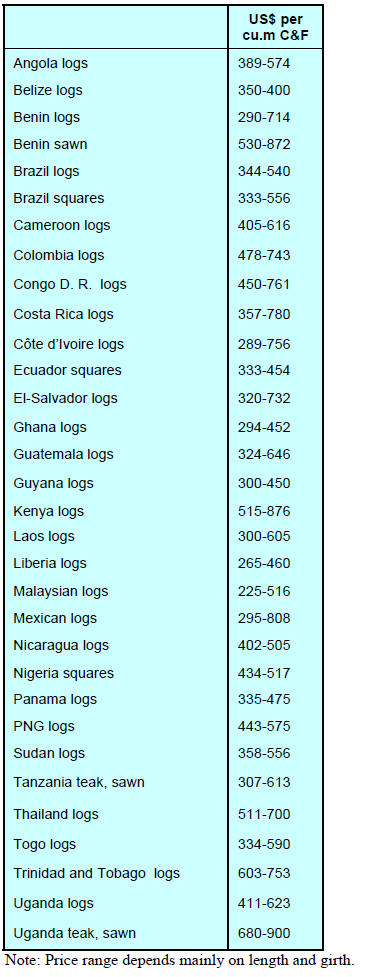
sawn hardwood prices
Demand and imports are stable, and prices are in the range
below, as previously reported.
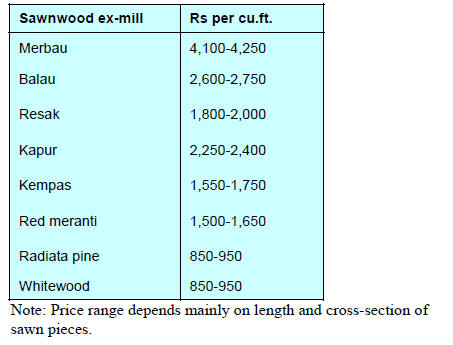
Myanmar teak prices
General financial conditions continue to improve in this
market, and prices have been steady.
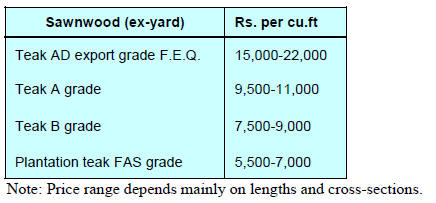
Sawn hardwood prices
Prices are unchanged from the previous edition except for
hemlock, which has declined significantly (by up to
Rs 900 per cubic ft), with lower-quality products now
being imported to meet smaller-dimension requirements,
mostly for furniture.
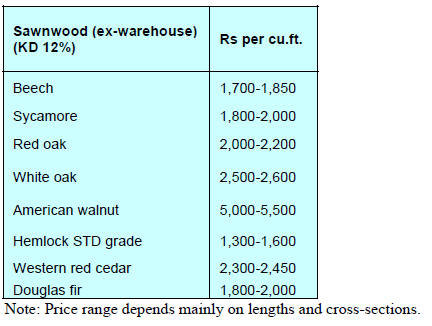
Plywood
Chinese plywood arrivals continue to increase as a result
of the reduced volumes going to the US market due to the
trade dispute between China and the US. Prices are
unchanged from the previous edition.
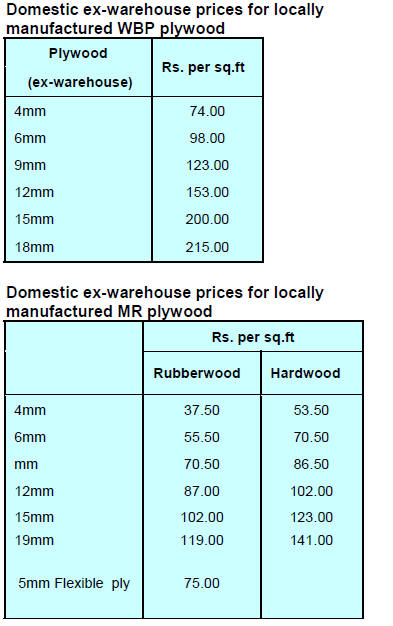
7.
VIETNAM
Exports, imports still growing
Vietnam exported wood and wood products valued at US$
995 million in October 2019, bringing the total export
value in the first ten months of 2019 to US$ 8.52 billion,
up by 17.8% compared with the same period in 2018.
Combined, the US, China, Japan and the Republic of
Korea accounted for 80.6% of the total export value in the
first ten months of 2019. Viet Nam’s exports of wood and
wood products to the US grew by 11.5% over the period,
to US$ 2.09 billion.
Vietnam imported more than US$2 billion of wood and
wood products in the first 9 months of 2019. China is the
single biggest supplier, accounting for 22.9% of the total
value (US$430 million), up by 41.4% compared with the
same period in 2018.
The second-largest supplier was the US, with a total
import value of US$258 million, up by 12.4% compared
with the same period in 2018.
There was also a marked increase of imports from the
Russian Federation from a relatively low base.
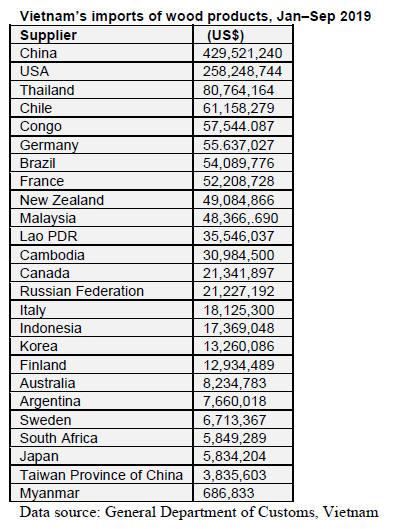
US investigates imported Vietnamese plywood
The import tariff on Vietnamese plywood in the US
market is in range of 0–8%; meanwhile, the anti-dumping
duty on Chinese plywood is 183.36% and the anti-subsidy
tariffs for imported Chinese plywood are 22.98–194.90%.
The US Department of Commerce conducted an antievasion
tax investigation in September 2018 against
Chinese plywood products with an external veneer made
from pine.
According to the Chairman of Binh Duong Furniture
Association, Mr Dien Quang Hiep, “Previously, China
was always the biggest competitor of Vietnam in
exporting plywood into the US. Now, as impacts of the
US-China trade war, the US importers have to replace
Chinese partners by others like Viet Nam. That is why
Vietnam should take this advantage as a priority importing
market of the US in future.”
As reported in the previous edition, the Vietnamese timber
sector is concerned that the increasing gap in the trade of
wood and wood products between Vietnam and the US
will increase the risk of anti-dumping and anti-subsidy
investigations, with potentially serious impacts on the
Vietnam wood processing industry. This risk is becoming
a reality due to possible practices involving Vietnamese
and Chinese plywood manufacturers.
The US Customs and Border Protection has conducted an
investigation into Vietnamese plywood imports.
See: https://customsnews.vn/vietnamese-goods-most-sued-bythe-
us-for-trade-remedies-12516.html
8. BRAZIL
Mato Grosso reduces forest regulation red
tape
The state deputies of Mato Grosso approved a draft bill on
23 October 2019 that brings state legislation into line with
the Brazilian Forest Code, classifying wood consumers
according to the size of the undertaking. Thus, individuals
or companies considered large consumers are required to
submit sustainable supply plans (SSPs) indicating how
they will meet demand for raw materials and woodfuel.
Those consuming less than 49,500 cu.m of roundwood per
year do not need to submit SSPs.
The Center for Timber Producers and Exporters of Mato
Grosso State (CIPEM) expressed the view that the change
will reduce red tape in the sector. The previous proposal
required the preparation of SSPs by those consuming more
than 12,000 cu.m of roundwood per year. The bill also
requires that individuals and companies consuming more
than 24,000 stere metres per year of charcoal are required
to maintain or establish forests, directly or in partnership
with third parties, to ensure the sustainability of operations
through their SSPs.
Transforming Rio Grande do Sul furniture sector
The aim of a programme launched in mid-October in
Bento Gonçalves in the Brazilian state of Rio Grande do
Sul is to transform the Rio Grande do Sul furniture chain,
encompassing industry, commerce and services, to make it
more innovative, competitive and sustainable, according to
a report in Remade.
The “Connect: Furniture sector in Transformation”
programme has been created by the Furniture Sector
Transformation Center, led by the Brazilian Support
Service for Micro and Small Businesses (Sebrae-RS), with
support from the Furniture Industry Association of Rio
Grande do Sul (Movergs), the Bento Gonçalves Furniture
Industry Union (Sindmóveis), the Senai Institute of Wood
and Furniture Technology and the Brazilian Furniture
Industry Association (Abimóvel).
The programme is designed to benefit the sector as a
whole. “We are here to transform what already exists with
better approaches and a good business environment. We
need to break some paradigms, think big even though we
are small. So we need everyone to get involved,” said the
Furniture Sector Transformation Center president.
Mato Grosso forest sector seeks more access to EU
About 20 forest-sector actors in Mato Grosso attended a
workshop convened by the Center for Timber Producers
and Exporters of Mato Grosso State (CIPEM) in Cuiabá in
October 2019 on the prospects for increasing trade with
the EU.
The workshop was the result of a partnership between
CIPEM and the Netherlands-based Sustainable Trade
Initiative (IDH), signed in April 2019.
At the event, IDH presented data on the forest sector as
well as export scenarios and trade rules for supplying
major buyers in the EU.
According to IDH, Brazil has the capacity to trade around
40% of all wood consumed in the world, given its
approach to sustainable forest management and the fact
that the country has the planet’s largest areas of
rainforest—yet it produces only 10%. IDH indicated that
the State Secretariat of the Environment (SEMA)’s Forest
Products Trade and Transport System (SISFLORA) is
aligned with EU requirements.
Sustainability a requirement for export
The Brazilian Furniture Industry Association (Abimóvel)
says that entrepreneurs are becoming more aware that
sustainability leads to more effective resource
management, enabling them to be more competitive in
Brazil and in new market niches and to better align with
major consumer trends.
Many companies are changing their processes to suit these
market conditions. In partnership with the Brazilian Trade
and Investment Promotion Agency (Apex-Brazil),
Abimóvel has conducted studies that are now
underpinning initiatives to improve the ways in which
companies deal with sustainability, such as the Furniture
Sector Sustainability Program (SIMB). SIMB has emerged
as a tool to help Brazilian companies comply with
international requirements and align with new
consumption trends.
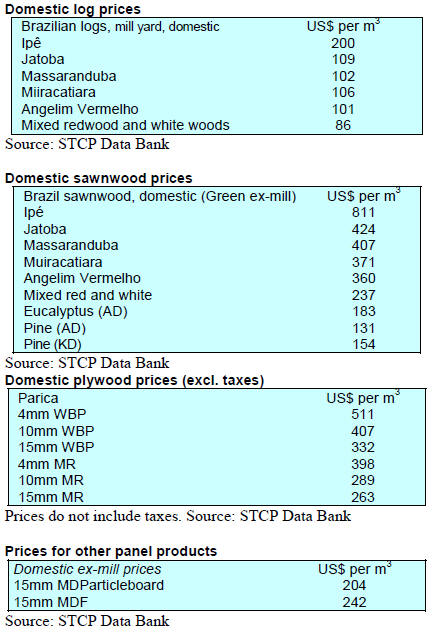
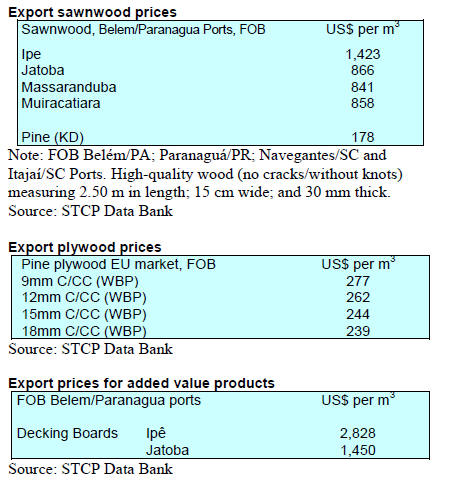
9. PERU
Peru’s first forest transparency portal
launched
Peru’s first forest transparency portal was launched in
October in the Loreto Region. The portal provides
information on how the Loreto forest authority is
managing the region’s forest and wildlife resources,
thereby contributing to transparency.
The portal is an initiative of the Loreto regional
government through its Forest Development and Wildlife
Management Department, with technical support from
USAID FOREST, the US Forest Service, and DAR, an
NGO.
The portal provides information in eight categories: 1)
regulatory and planning instruments; 2) inventory of forest
resources; 3) geographic information; 4) national forest
management; 5) forest and wildlife registries; 6) access
modalities; 7) forest and wildlife monitoring and control;
and 8) forest supervision. It integrates various national and
regional information systems developed by forestry
authorities, as well as information from other sources.
See:
http://transparenciagerfor.regionloreto.gob.pe
SERFOR announces traceability system
The National Forest and Wildlife Service (SERFOR)
recently published a document called “Traceability of
Timber Forest Resources” in the official newspaper El
Peruano, outlining its plan for a mechanism to track wood
and wood products from extraction in the forest to
commercialization.
The purpose of the mechanism is to guarantee legal origin
and promote sustainable forest management and
competitiveness.
The mechanism will have three main stages: registration
and verification; tracking through primary processing; and
a methodology for ensuring legality in secondary
processing.
Mexican fire expert advises Peru
Mexican Oscar Rodríguez, a forest fire management
expert, has visited Peru to provide advice on training
personnel in forest firefighting. The visit was supported by
USAID FOREST and the US Forest Service.
Rodríguez has broad experience in forest fire control and
training in several Latin American countries. The visit is
part of efforts to develop a standardized curriculum and
improvement of the qualification system so that forest
firefighters trained in Peru will attain the same standard as
those of their peers in other countries in the region. This
will also better enable Peruvian institutions to work
together to address forest fires.
Peru charges illegal loggers in Amazon deaths
Authorities in Peru have charged five men in the timber
industry with the 2014 murders of four indigenous
activists who had battled illegal logging in the Amazon.
Two timber executives and three loggers have been
charged with the shooting deaths of the activists, said
prosecutor Otoniel Jara, who works in the Ucayali region.
Environmentalists say the case is unprecedented in Peru.
See:
https://www.japantimes.co.jp/news/2019/11/01/world/crimelegal-
world/peru-charges-loggers-over-amazondeaths/#.
XcijuSMzbIU
